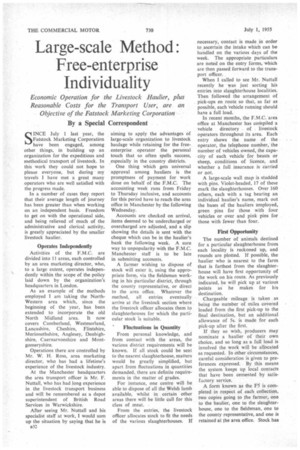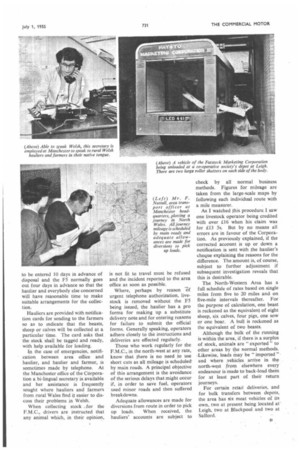Large-scale Method: Free-enterprise Individuality
Page 58

Page 67

If you've noticed an error in this article please click here to report it so we can fix it.
Economic Operation for the Livestock Haulier, plus Reasonable Costs for the Transport User, are an Objective of the Fatstock Marketing Corporation
By a Special Correspondent
SINCE July 1 last year, the Fatstock Marketing Corporation have been engaged, among other things, in building up an organization for the expeditious and methodical transport of livestock. In this work they could not hope to please everyone, but during my travels I have met a great many operators who are well satisfied with the progress made.
In a number of cases they report that their average length of journey has been greater than when working on an independent basis_ Freedom to get on with the operational side, and being relieved of much of the administrative and clerical activity, is greatly appreciated by the smaller livestock haulier.
Operates Independently
Activities of the F.M.C. are divided into Ii areas, each controlled by an area marketing director, who, to a large extent, operates independently within the scope of the policy laid down by the organization's headquarters in London.
As an example of the methods employed I am taking the NorthWestern area which, since the beginning of the year, has been extended to incorporate the old North Midland area. It now covers Cumberland, Westmorland, Lancashire, Cheshire, Flintshire, Merionethshire, Anglesey, Denbighshire, Caernarvonshire and Montgomeryshire.
Operations there are controlled by Mr. W. H. Ross, area marketing director, who has had a lifetime's experience of the livestock industry.
At the Manchester headquarters the area transport officer is Mr. F. Nuttall, who has had tong experience in the livestock transport business and will be remembered as a depot superintendent of British Road Services in Warwickshire.
After seeing Mr. Nuttall and his specialist staff at work, I would sum up the situation by saying that he is B32 aiming to apply the advantages of large-scale organization to livestock haulage while retaining for the freeenterprise operator the personal touch that so often spells success, especially in the country districts.
One thing which gets universal approval among hauliers is the promptness of payment for work done on behalf of the F.M.C. The accounting week runs from Friday to Thursday inclusive, and accounts for this period have to reach the area office in Manchester by the following Wednesday.
Accounts are checked on arrival, items deemed to be undercharged or overcharged are adjusted, and a slip showing the details is sent with the cheque which can be in the haulier's bank the following week. A sure way to unpopularity with the F.M.C. Manchester staff is to be late in submitting accounts.
A farmer wishing to dispose of stock will enter it, using the appropriate form, via the fieldsman working in his particular district, through the county representative, or direct to the area office. Whatever the method, all entries eventually arrive at the livestock section where the livestock officer allocates them to slaughterhouses for which the particular stock is suitable.
Fluctuations in Quantity
From personal knowledge, and from contact with the areas, the various district requirements will be known. If all stock could be sent to the nearest slaughterhouse, matters would be greatly simplified, but apart from fluctuations in quantities demanded, there are definite requirements in the matter of grades.
For instance, one centre will be able to dispose of all the Welsh lamb available, whilst in certain other areas there will be little call for this class of meat. •
From the entries, the livestock officer allocates stock to fit the needs of the various slaughterhouses. If
necessary, contact is made in order to ascertain the intake which can be handled on the various days of the week. The appropriate particulars are noted on the entry forms, which are then passed forward to the transport officer.
When I called to see Mr. Nuttall recently he was just sorting his entries into slaughterhouse localities. Then followed the arrangement of pick-ups en route so that, as far as possible, each vehicle running should have a full load.
In recent months, the F.M.C. area office at Manchester has cotinpiled a vehicle directory of livestock operators throughout its area. Each entry shows the name of the operator, the telephone number, the number of vehicles owned, the capacity of each vehicle for beasts or sheep, conditions of licence, and whether a full insurance is carried or not.
A large-scale wall map is studded with pins. Violet-headed, 17 of these mark the slaughterhouses. Over 160 others, each with a tag bearing an individual haulier's name, mark out the bases of the hauliers employed, green pins for those with four vehicles or over and pink pins for those with fewer than four_
First Opportunity
The number of animals destined for a particular slaughterhouse from each locality is reckoned up, and rounds are plotted. If possible, the haulier who is nearest to the farm that is farthest from the slaughterhouse will have first opportunity of the work on his route. As previously indicated, he will pick up at various points as he makes for his destination.
Chargeable mileage is taken as being the number of miles covered loaded from the first pick-up to the final destination, but an additional allowance of 5s. is made for each pick-up after the first.
If they so wish, producers may nominate a haulier of their own choice, and so long as a full load is involved the work will be allocated as requested. In other circumstances, careful consideration is given to preferences expressed. By this means the system keeps up local contacts that have been cemented by satisfactory service.
A form known as the F5 is completed in respect of each collection, two copies going to the farmer, one to the haulier, one to the slaughterhouse, one to the fieldsman, one to the county representative, and one is retained at the area office. Stock has to be entered 10 days in advance of disposal and the F5 normally goes out four days in advance so that the haulier and everybody else concerned will have reasonable time to make suitable arrangements for the collection.
Hauliers are provided with notification cards for sending to the farmers so as to indicate that the beasts, sheep or calves will be collected at a particular time. The card asks that the stock shall be tagged and ready, with help available for loading.
In the case of emergencies, notification between area office and haulier, and haulier and farmer, is sometimes made by telephone. At the Manchester office of the Corporation a bilingual secretary is available and her assistance is frequently sought where hauliers and farmers from rural Wales find 4 easier to discuss their problems in Welsh.
When collecting stock ,for the F.M.C., drivers are instructed that any animal which, in their opinion, is not fit to travel must be refused and the incident reported to the area office as soon as possible.
Where, perhaps by reason -Of urgent telephone authorization, livestock is removed without the F5 being issued, the haulier has a pro forma for making up a substitute delivery note and for entering reasons for failure to submit the official forms. Generally speaking, operators adhere closely to the instructions and deliveries are effected regularly.
Those who work regularly for the F.M.C., in the north-west at any rate, know that there is no need to use short cuts as all mileage is scheduled by main roads. A principal objective of this arrangement is the avoidance of the serious delays that might occur if, in order to save fuel, operators used minor roads and then suffered breakdowns.
Adequate allowances are made for diversions from route in order to pick up loads. When received, the hauliers' accounts are subject to check by all normal business methods. Figures for mileage are taken from the large-stale maps by following each individual route with a mile measurer.
As I watched this procedure I saw one livestock operator being credited with over 116 when his claim was for i13 5s. But by no means all errors are in favour of the Corporation. As previously explained, if the corrected account is up or down a notification is sent with the haulier's cheque explaining the reasons for the difference. The amount is, of course, subject to further adjustment if subsequent investigation reveals that this is desirable.
The North-Western Area has a full schedule of rates based on single miles from five to 20 miles andon five-mile intervals thereafter. For the purpose of calculation, one beast is reckoned as the equivalent of eight sheep, six calves, four pigs, one sow or one boar. A bull is reckoned as the equivalent of two beasts.
Although the bulk of the running is within the area, if there is a surplus of stock, animals are " exported " to other areas by the normal methods. -Likewise, loads may be "imported " and where ,vehicles arriye in the north-west from elsewhere every endeavour is made to back-load them for at least part of their return journeys.
For certain retail deliveries, and for bulk transfers between depots, the area has six meat vehicles of its own, two at present being located at Leigh, two at Blackpool and two at Salford.












































































































































